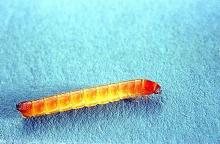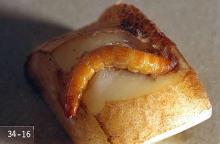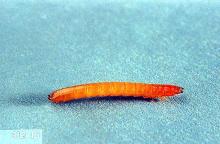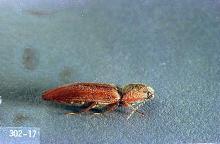Sugar beet wireworm (Limonius californicus)
Pacific Coast wireworm (Limonius canus)
Pest description and crop damage Smooth, hard-bodied, cylindrical, shiny tan "worms" about 1 inch long when mature. They have 3 pairs of small, thin legs behind the head; last abdominal segment with characteristic "keyhole" notch. Damage from larval feeding appears as seed destruction during germination. On older plants, wireworms scar and channel the taproot surface as well as chew winding tunnels into the taproot.
Sugar beets following grassy pastures are at highest risk for wireworm infestations, because, like white grubs, wireworms prefer grasses for egg laying and larval feeding, and wireworm larvae may require 2 to 4 (or even more) years for egg-to-adult development. Corn or cereals in rotation with sugar beets also increase the probability of wireworm infestations, especially if reduced tillage in rotational crops leaves high amounts of organic matter and crop residues in the soil.
Scouting and thresholds No formal economic thresholds exist for wireworm insecticide treatment decisions. In problem fields, use wireworm seed treatments for cereal crops grown in rotation with sugar beets. There are no effective "rescue" treatments that can be applied postemergence in sugar beets for wireworms. Use field history and wireworm baiting stations to determine need for at-planting insecticide treatment against wireworms.
Management-chemical control
When chemical control is needed, at-plant insecticides (Table 1) are the preferred option given the potential for early season stand loss.





